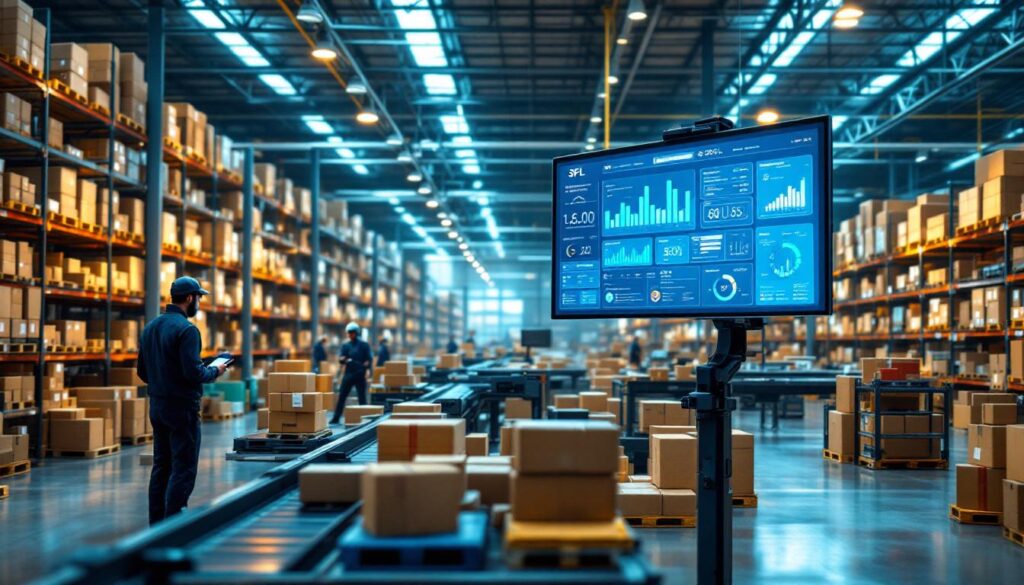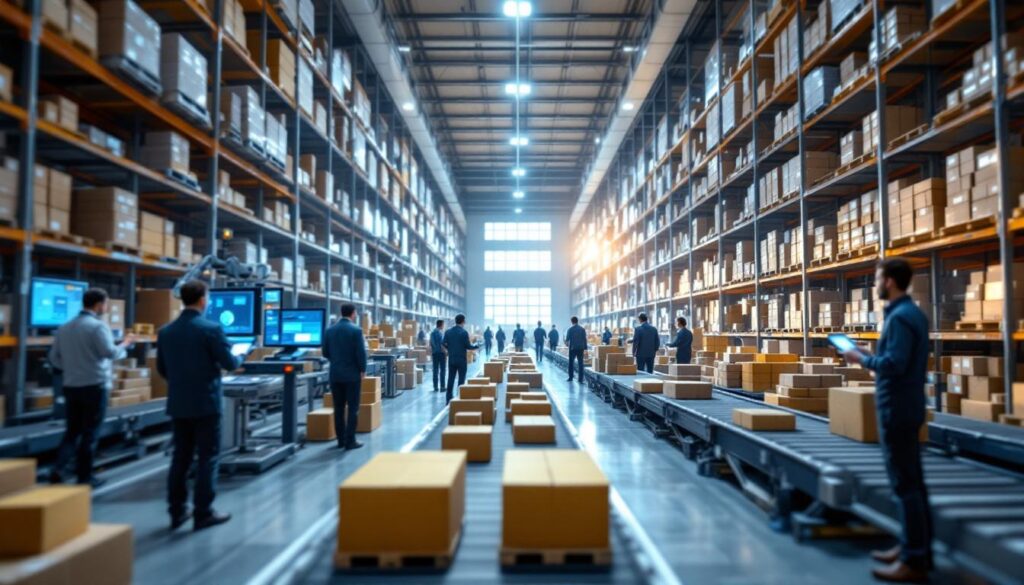High-volume fulfillment centers are under more pressure than ever. Orders keep rising, expectations for speed and accuracy keep getting higher, and the room for error keeps shrinking. The right 3PL software can ease these challenges, helping warehouses scale and automate while staying sharp and competitive.
In 2025, operators demand software that keeps up with fast order processing, adapts to changing regulations, and produces error-free results. Customers expect full transparency and instant delivery, while compliance rules require careful tracking of inventory and shipments. Reliable 3PL software is the backbone that supports every piece of this operation.
Leanafy stands out by delivering the features fulfillment centers need most. It helps teams manage rising order volumes, cut mistakes, and streamline daily work. If you’re looking for smarter warehouse management, WMS boosts 3PL growth by showing how software can drive efficiency and better results. Let’s look closer at the top 3PL software solutions set to power high-volume fulfillment in 2025.
Key Features to Look for in 3PL Software for High-Volume Fulfillment
Choosing 3PL software for a high-volume fulfillment center isn’t just about ticking boxes. The right platform should remove bottlenecks, help you manage peaks, and keep your warehouse humming when orders spike. Below, you’ll find the standout features you need to keep every shipment on time and every customer happy.
Automation and Workflow Efficiency
Modern fulfillment is a race against the clock. Automated picking, packing, and shipping features are essential for supporting high order volumes. With the right 3PL software, repetitive tasks become faster and less prone to mistakes. Here’s how automation changes the game:
- Automated picking: Systems guide staff with optimized routes and order batches, reducing walk time and errors.
- Smart packing logic: The software determines the best box sizes and prevents costly rework.
- One-click shipping: Carrier selection and label generation are done in moments, ensuring orders move out without delay.
Leanafy leads by making these workflows simple to set up and easy to track. Removing manual steps means you can send more packages with less staff, and accuracy rarely slips.
Scalability and Customization
As your business grows, so do your needs. High-volume operations face seasonal surges, new product lines, and unexpected demand jumps. You need 3PL software that doesn’t hit a wall just when things get busy.
Top-tier platforms offer:
- Modular features you can add when ready—such as returns, kitting, or international shipping—so you pay for what you use.
- Flexible user roles and workflows that adapt as teams expand or needs shift.
- Real-time performance dashboards that make it clear where to allocate resources.
Leanafy is built to support these shifts. Whether handling Black Friday spikes or expanding into new markets, the right software should serve as a launch pad, not a roadblock.
Seamless Integrations with Other Platforms
Today’s high-volume fulfillment relies on more than just a warehouse management system. 3PL software must connect with marketplaces, EDI partners, ERP solutions, and shipping carriers to keep orders moving and data accurate.
Key integration points to look for:
- Marketplace sync: Orders flow in from Amazon, Shopify, Walmart, and more—no copy-pasting needed.
- EDI (Electronic Data Interchange): Stay in sync with vendors and retailers without spreadsheets.
- ERP connections: Accounting, inventory, and sales data auto-update as business happens.
- Shipping carriers: Real-time rates and tracking with major providers, so customers get updates instantly.
Leanafy stands out with plug-and-play connections to over 200 services. To see what integrations can do for your workflows, visit the LeanAfy Integrations Overview.
When tools exchange data smoothly, your team spends less time on manual entry and more time serving customers. That’s how top fulfillment centers stay ahead.
Comparison: Leading 3PL Software Solutions for 2025
Choosing the right 3PL software can be the deciding factor between smooth growth and ongoing headaches in a high-volume fulfillment center. In this section, we compare top options for 2025 to help you see what sets each apart when orders stack up and compliance is key.
Leanafy: Built for High-Volume Excellence
Leanafy is designed to keep up with even the busiest 3PL warehouses. If your operation needs a platform that scales as you grow, automates routine tasks, and supports compliance, Leanafy stands out from the rest.
What makes Leanafy unique for high-volume fulfillment?
- Smart automation for every workflow: Leanafy automates inventory movements, order picking, and shipping confirmations. Its algorithms reduce errors and boost throughput, allowing teams to handle peak volumes without sacrificing accuracy.
- Compliance management: Regulations for products like food, supplements, alcohol, and hazmat materials change constantly. Leanafy tracks batch numbers, expiration dates, and storage requirements, supporting full compliance. See how Leanafy approaches Handling Regulated Products in 3PL.
- Rapid scalability: Whether your operation manages thousands or millions of SKUs, Leanafy adds new users, storage zones, and locations with minimal IT work. System resources adjust quickly, so you never feel boxed in by your software.
- Best-in-class customer support: Leanafy offers live onboarding, 24/7 support, and ongoing training. Their team answers tickets fast and fixes issues before they impact operations.
- Broad integration support: Connecting with sales channels, ERP systems, and EDI partners is a breeze. Leanafy’s support for varied WMS integration types means you can plug in new systems as your needs shift.
If your fulfillment center wants a single platform that supports growth and shields you from costly compliance errors, Leanafy deserves a top spot on your list.
Other Noteworthy 3PL Platforms
While Leanafy sets a high bar, a few other 3PL software solutions are worth mentioning for high-volume environments:
1. ShipBob
- Automation: ShipBob is known for its fast onboarding and automated workflows that help even smaller brands scale. Automated order routing, picking, and shipping streamline daily work.
- Integrations: It connects natively to platforms like Shopify, Amazon, Walmart, and top e-commerce tools. You can automate much of the order flow without extra setup.
- Analytics: ShipBob provides real-time dashboards focused on order status, inventory health, and shipping speeds, allowing for quick decision-making.
- Support: While they offer responsive chat and knowledge base support, some users report slower turnaround on complex tickets.
2. 3PL Central (now Extensiv 3PL Warehouse Manager)
- Robust automation: Their advanced rule engine lets you auto-assign orders, locations, and carrier preferences based on factors like order type, SKU, or customer.
- Integration variety: Extensiv connects with everything from marketplaces to ERPs to carriers, making it flexible for fast-growing 3PLs. API support is deep for teams with custom requirements.
- Detailed analytics: See trends in inventory, order fulfillment times, and labor usage. Their system highlights exceptions and late orders so you can act quickly.
- Scalability: It’s designed for multi-client, multi-warehouse environments and can handle large SKU counts without lag.
3. SkuVault
- Automation: SkuVault’s pick/pack/ship features speed up warehouse operations and minimize mis-ships.
- Integrations: Native support for leading platforms like Shopify and WooCommerce, plus many shipping providers. This streamlines everything from order capture to final delivery.
- Analytics: Offers strong inventory tracking and reporting. SkuVault helps uncover out-of-stock risks and slow movers.
- Customer support: Reviews praise their helpful onboarding, though some advanced automation features may require a learning curve.
Each of these platforms brings something different to the table, but they all focus on automation, tight integrations, and advanced analytics—the foundation for any high-volume operation. When comparing your options, factor in your unique workflow, compliance requirements, and how quickly you need to adapt to growth.
Cloud vs On-Premises: The Best Deployment for High-Volume 3PL Operations
Choosing between cloud and on-premises deployment might feel like picking between speed and control. High-volume 3PL operations depend on speed, accuracy, and adaptability—making the right deployment model crucial for your success. Let’s compare these options side-by-side to help you find the best fit for your fulfillment center.
Cloud Deployment: Flexibility and Scalability at Your Fingertips
Cloud-based 3PL software shines when quick growth and round-the-clock access matter most. Hosting your warehouse management platform in the cloud means no heavy servers on-site, less IT overhead, and the ability for teams to log in from anywhere. Updates happen automatically behind the scenes, so your tools are always current.
Here’s what makes the cloud such a strong choice for high-volume fulfillment:
- Rapid scaling: Add new users, clients, or warehouse zones without reconfiguring hardware. Whether order volumes spike or steady growth brings new demands, the cloud stretches with you.
- Resilience and uptime: Most cloud solutions back up your data and promise high uptime, keeping your teams rolling even during local outages.
- Mobile access: Teams can manage inventory and track orders from tablets and smartphones, boosting floor productivity and real-time problem solving.
- Lower upfront costs: Skip the expensive servers and complex IT projects. You pay for what you use—perfect for centers with shifting needs.
Solutions like Leanafy are built cloud-first. This means you get top speed, regular security updates, and the horsepower to handle holiday peaks or unexpected surges. For a closer look at how cloud deployment fuels growth, see how WMS boosts 3PL growth across different warehouse models.
On-Premises Deployment: Full Control for Complex Needs
On-premises deployment gives you complete ownership and strict data control. Your servers, your rules. While it’s no longer the go-to for every fulfillment center, some 3PLs prefer this method—especially when strict compliance or high customization are required.
When might on-premises deployment suit your operation?
- Data governance: Full data sovereignty appeals to centers managing regulated products or those with special privacy requirements.
- Customization: On-premises systems can be tailored from the ground up. If you have legacy equipment or highly specific workflows, this path might be more compatible.
- Reliable local performance: Even if your internet drops, on-premises software keeps running as long as your local infrastructure is sound.
However, these perks come with some added weight:
- Big initial investment in hardware and IT staff.
- Longer setup times due to physical installations and system tuning.
- Manual updates and backups put extra work on your tech team.
For fast-growing 3PL services, especially those handling many clients and rapid changes, the cloud usually brings more value. On-premises may be suitable for operators who need advanced control and are willing to manage more of their own tech.
Which Deployment Wins in 2025?
Cloud deployment is rapidly becoming the standard, giving fulfillment centers the agility to pivot and scale. With high-volume operations, the small delays and maintenance risks of on-premises systems can turn into costly bottlenecks.
Modern platforms like Leanafy put cloud technology front and center, combining speed with regular updates and security. You get a system that grows as you do—whether you’re adding new locations, onboarding more users, or reacting to new regulations overnight.
If your focus is rapid growth, cost control, and working without boundaries, cloud deployment stands out as the top choice for 3PL software in 2025. For deep dives into warehouse tech strategies and what makes cloud solutions resilient, check out industry perspectives on WMS boosts 3PL growth.
High-volume fulfillment centers need technology that keeps up with their ambitions. The right deployment model—especially with partners like Leanafy—could be the difference between chasing orders and leading the pack.
Benefits of 3PL Software in High-Volume Fulfillment Centers
Running a high-volume fulfillment center means you’re always looking for new ways to boost output and cut down on mistakes. When shipments are flying out by the thousands each day, even the smallest hiccup can snowball into bigger headaches for you and your clients. This is where the right 3PL software proves its value, helping you keep operations smooth and customers happy. Let’s break down the biggest benefits you get from a strong 3PL platform—especially when you use a modern solution like Leanafy.
Faster Order Processing and Fewer Errors
Speed and accuracy go hand in hand in busy fulfillment centers. The top 3PL software helps your team move faster without increasing mistakes.
- Automated pick and pack: Barcode scanning, digital lists, and guided routes help workers grab the right items quickly.
- Real-time inventory: Know what’s in stock and what needs reordering at a glance, cutting down on missed shipments.
- Fewer manual tasks: Automation reduces typos and helps avoid mis-picks or shipping to the wrong address.
With Leanafy, these features are built to scale. When your order volume doubles overnight, your processes keep humming—no chaos, just reliable fulfillment.
Better Scalability for Growth
Your software needs to keep up whether you’re handling 1,000 or 100,000 orders a day. Leading 3PL platforms make scaling up or down a breeze.
- Flexible modules: Add or remove features for things like returns management or new shipping options, paying only for what you need.
- Easy onboarding: Bring new users and clients into your system without weeks of training.
- Configurable workflows: Switch up pick paths, storage locations, or packing rules as your business evolves.
Leanafy is built for this kind of growth, helping you shift gears as sales spike or product lines expand. To see how warehouse management systems make this possible, the WMS boosts 3PL growth article shares useful real-world examples.
Tighter Control Over Inventory and Data
Losing track of a single pallet could cost you a client. Advanced 3PL software delivers deep control, even in sprawling warehouses.
- Live location tracking: Always know where every product, SKU, or lot code is stored.
- Batch and expiration monitoring: Meet industry rules for food, supplements, or regulated products without extra paperwork.
- Audit trails and logs: Every action is tracked, supporting error resolution and compliance.
Leanafy stands out by offering these controls through an easy dashboard that gives everyone—from floor staff to managers—the data they need, when they need it.
Smarter Integrations with Key Systems
You can’t run a high-volume center on software islands. Leading 3PL software connects your operation to stores, carriers, and partner systems.
- Multi-channel order sync: Orders flow right from your sales channels or clients, no need for manual entry.
- Carrier and ERP links: Shipping carriers, EDI trading partners, accounting, and more—all tied together, keeping data in sync.
- Custom rules and automations: Set automated triggers for billing, restocking, or client notifications.
Leanafy offers deep, flexible connections to over 200 platforms, making it easy to plug into your clients’ systems or new partners. A complete WMS integrations guide outlines options that help you avoid data silos and manual re-entry.
Reliable Compliance and Security
Regulated products, dangerous goods, or high-value items bring added risk. The right 3PL software gives you features to stay compliant and protect your data.
- Automated record keeping: Logs shipments, handling, and storage—all audit-ready.
- Custom restrictions: Rules by SKU, lot, or customer ensure only trained staff access special items.
- User permissions and roles: Let each user see only what they need, protecting sensitive client or inventory information.
Leanafy takes compliance seriously, letting you avoid costly fines or accidental slip-ups that could damage your reputation.
Cost Savings and Better Margins
Finally, time is money—especially when it comes to high-volume fulfillment. The best 3PL platforms help you avoid waste and increase overall profitability.
- Faster shipments: Lower labor costs by speeding up pick, pack, and ship steps.
- Fewer shipping errors: Reduce costly returns and reshipments.
- Stronger analytics: Find slow movers, shrinkage, and underused space so you can fix issues fast.
With Leanafy, these improvements aren’t just nice extras—they’re core to the platform, helping you save on every order while keeping your operation ready for whatever comes next.
Investing in 3PL software that matches your center’s pace isn’t just a tech upgrade. It’s the foundation for long-term, profitable growth when handling high volumes—giving you peace of mind and room to win new business.
Future Trends: What’s Next for 3PL Software in Fulfillment Centers?
With customer demands rising and order complexity increasing, fulfillment centers can’t stay ahead by standing still. The next few years promise big changes as 3PL software keeps pace with what operators and clients expect. From AI-driven insights to automation that rewrites the rulebook, new trends are shaping how warehouses run. Here’s a look at where 3PL software is heading and what high-volume operations should watch.
Artificial Intelligence and Predictive Analytics
The future of 3PL software belongs to smarter, more adaptable platforms. AI and predictive analytics are moving from buzzwords to must-haves. These tools quickly spot trends, such as shifts in demand, bottlenecks in the warehouse, or early signs of stock shortages.
- Predictive order routing: Software will forecast order spikes and reroute inventory ahead of delays, slashing ship times.
- Automated labor management: AI can suggest staffing changes based on day-to-day or even hour-to-hour forecasts.
- Intelligent exception handling: Systems flag problems early and recommend fixes, keeping fulfillment centers proactive instead of reactive.
Leanafy is already exploring these advanced data tools, helping centers handle peak days and keep customers happy.
Hyperautomation and Robotics Integration
Automation is no longer a bonus—it’s a requirement. Fulfillment centers are scaling up by connecting 3PL software with robotics and advanced warehouse tech. Gone are the days when barcode scanners were the peak of automation.
- Robot-friendly software: Modern 3PL platforms like Leanafy work hand-in-hand with autonomous mobile robots, conveyor systems, and smart sortation technology.
- Task orchestration: The software acts as the central conductor, assigning tasks to both human workers and robots.
- Automated returns: Returns move through scanning, assessment, and restocking with little to no manual input.
Operations get faster, and staff focus shifts to value-added work rather than repetitive, manual labor.
Personalization and DTC Expectations
Customers expect more than fast shipping—they want personalized service, real-time tracking, and flexible delivery options. 3PL software will need to support direct-to-consumer fulfillment models and adapt to new forms of customization.
Expect features like:
- Live inventory and order updates for both B2B and DTC clients.
- Custom-branded packing slips or special handling notes for each order.
- Inventory segmentation so that each client keeps their branding, offers, or subscription specials on track.
Companies like Leanafy bring these capabilities to life by powering DTC order fulfillment and adjusting to fast-changing retail needs.
More Robust Cloud Native Solutions
Cloud-based software isn’t just a trend; it’s quickly becoming the standard. Tomorrow’s 3PL software will focus on even stronger cloud-first design, building faster, more reliable access across multiple facilities and remote teams.
Growing demands for:
- Real-time data sharing: See every order, inventory change, and shipment without delays.
- Easy scaling: Onboard new locations or clients overnight without new servers.
- Anywhere access: Manage your operation from any device, anytime.
This push toward the cloud also unlocks easier integration with partner systems, suppliers, and clients. Those still comparing options should check out key insights in the Cloud WMS vs On-Premises Comparison.
Stronger Data Security and Compliance Controls
As more data flows through 3PL software, security and compliance will stay in the spotlight. Operators must meet privacy laws, secure customer data, and handle regulated goods with airtight controls.
Look for:
- Automated compliance monitoring: The software will check each step—from picking to final shipment—against regulatory demands, flagging anything that could raise concerns.
- Real-time audit trails: Detailed records of who did what and when, supporting fast audits and building trust with clients.
- Enhanced permission controls: Make sure users only access what they need, protecting sensitive info across the board.
Leanafy has embraced these features, making sure high-volume centers can expand without risking costly mistakes.
Adaptability for New Channels and Technology
Omnichannel fulfillment is the new normal. 3PL software will need to keep up with emerging sales channels, delivery partners, and technology standards.
- Plug-and-play integrations: With APIs and new marketplace connections, adding a new client or shipping partner won’t slow you down.
- Support for IoT and real-time tracking: As sensors and smart tags spread, 3PL platforms will pull in even more data for sharper decisions.
- Flexible billing and service models: Adapting pricing or workflows for subscription, wholesale, and DTC clients, without multiple tools.
By building for flexibility, leaders like Leanafy help warehouses pivot as fast as consumer shopping habits change.
The future for 3PL software in fulfillment centers promises more speed, better customization, and tighter control. Operators who ride these trends—from AI-driven decisions to full robotics integration—can turn their warehouses into true engines of growth.
Conclusion
High-volume fulfillment centers can’t reach their full potential without the right 3PL software at the core. Platforms like Leanafy push warehouse operations forward with the kind of automation, integration, and flexibility needed to keep up with rising demand. Choosing a system that grows with you and simplifies complex challenges means smoother days, fewer errors, and happier clients.
Leanafy shines as a future-ready solution, helping operators scale, streamline, and adapt to what’s coming next. Want to explore more about how specialized technology can transform your warehouse? Take a look at the Lean Warehouse Management System for a deeper breakdown of features fit for high-volume 3PLs.
The right 3PL software doesn’t just handle today’s volume—it opens up new possibilities for tomorrow. Thanks for sticking with us to the end. If you have thoughts or experiences with fulfillment tech, feel free to join the discussion.





